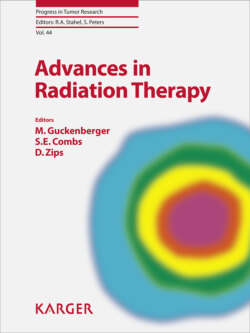Читать книгу Advances in Radiation Therapy - Группа авторов - Страница 36
На сайте Литреса книга снята с продажи.
Causes of Hypoxia
ОглавлениеThe blood supply of a malignant tumor is often suboptimal as the vascular network is immature and chaotic. This chaotic vascular network results in tumor hypoxia [23]. Mainly 2 forms of hypoxia exist [14]: chronic, diffusion-limited and acute perfusion-limited hypoxia [17]. In chronic hypoxia, tumor cells at a certain distance from blood vessels (100–150 μm) are beyond the maximal diffusion distance for oxygen [14]. This distance is even shorter due to the increased oxygen consumption in rapidly dividing tumor cells, with chronic hypoxia depending on both supply and demand. (Chronically) hypoxic tumor cells have exceeded the oxygen capacity of the newly formed vascular network. This is due to the fact that the new microvasculature is often insufficient in providing normoxic circumstances in the distant tumor areas and will thereby contribute to diffusion-limited hypoxia [23]. Anemia and hypoxemia can also cause, and certainly contribute to, chronic hypoxia [17]. Imaging tracers are predominantly markers for chronic hypoxia, because hypoxia needs to persist for a period of time that is sufficiently long enough to allow targeting and binding [14].
Another form of hypoxia is acute, perfusion-limited hypoxia, which is caused by the transient opening and closing of blood vessels, producing fluctuations in perfusion of tumor regions, and changes in oxygen tension [14]. The structural and functional abnormalities in the newly formed vasculature cause malfunctioning of the blood supply. This in turn results in an unstable blood flow causing intermittent hypoxia close to poorly organized vessels. This form of hypoxia is characterized by rapidly changing oxygen concentrations [23]. Acute hypoxia cannot be reliably imaged using tracers. Its relevance for prognosis is unclear, whereas (acute) hypoxia during radiation treatment will surely attenuate treatment efficacy. The chaotic and complex vascularization of tumors results in a mixture of areas of predominant acute, chronic, or a mixture of these 2 states of hypoxia.
